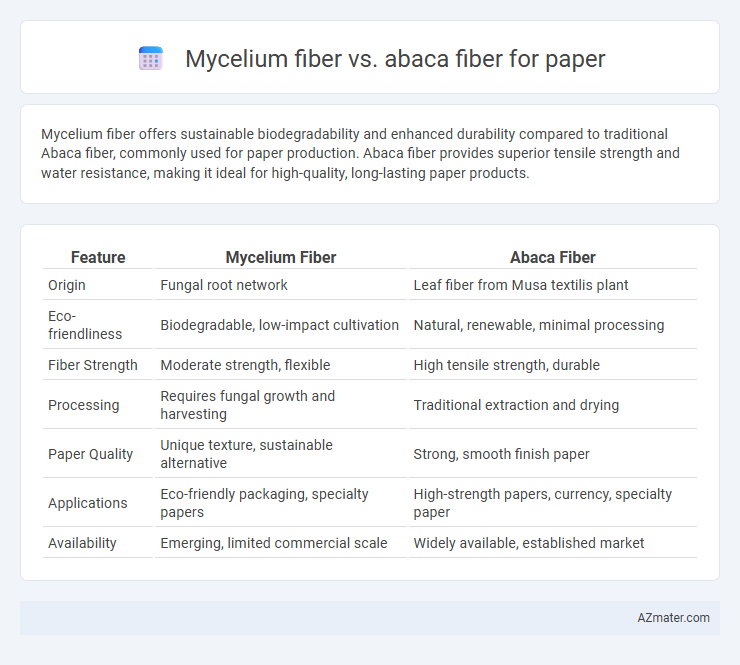Mycelium fiber offers sustainable biodegradability and enhanced durability compared to traditional Abaca fiber, commonly used for paper production. Abaca fiber provides superior tensile strength and water resistance, making it ideal for high-quality, long-lasting paper products.
Table of Comparison
| Feature | Mycelium Fiber | Abaca Fiber |
|---|---|---|
| Origin | Fungal root network | Leaf fiber from Musa textilis plant |
| Eco-friendliness | Biodegradable, low-impact cultivation | Natural, renewable, minimal processing |
| Fiber Strength | Moderate strength, flexible | High tensile strength, durable |
| Processing | Requires fungal growth and harvesting | Traditional extraction and drying |
| Paper Quality | Unique texture, sustainable alternative | Strong, smooth finish paper |
| Applications | Eco-friendly packaging, specialty papers | High-strength papers, currency, specialty paper |
| Availability | Emerging, limited commercial scale | Widely available, established market |
Introduction to Mycelium Fiber and Abaca Fiber
Mycelium fiber, derived from the root structure of fungi, offers biodegradability and sustainability benefits in paper production. Abaca fiber, obtained from the Musa textilis plant, is known for its high strength, durability, and resistance to saltwater, making it ideal for specialty papers and packaging. Both fibers present eco-friendly alternatives to traditional wood pulp, with mycelium contributing natural fungicidal properties and abaca providing superior tensile strength.
Origins and Sources of Mycelium and Abaca Fibers
Mycelium fiber originates from the root-like structures of fungi, primarily sourced from mushroom species that grow on organic waste, enabling sustainable and rapid cultivation. Abaca fiber, derived from the leaf stalks of the Abaca plant (Musa textilis), is native to the Philippines and thrives in tropical climates, making it a traditional and renewable resource for paper production. The contrasting origins highlight mycelium's fungal biotechnology compared to abaca's agricultural plant-based sourcing, influencing their unique material properties and environmental impact.
Environmental Impact and Sustainability
Mycelium fiber, derived from fungal root structures, offers a biodegradable and low-impact alternative to traditional fibers like Abaca, which is sourced from Musa textilis plants. Mycelium growth requires minimal water, no pesticides, and captures carbon during production, making it a more sustainable option compared to Abaca cultivation that typically involves significant land use and chemical inputs. Both fibers contribute to reducing deforestation and promote eco-friendly paper production, but Mycelium's rapid growth and renewable nature position it as a superior choice for sustainable packaging and paper industries.
Fiber Structure and Physical Properties
Mycelium fiber exhibits a highly porous and interwoven hyphal network structure, providing excellent tensile strength and lightweight properties ideal for sustainable paper production. In contrast, Abaca fiber, derived from Musa textilis plants, features long, stiff, and coarse fibers with superior moisture resistance and durability, making it suitable for high-strength and water-resistant paper products. The unique microfibril angle and cellulose content in Abaca contribute to greater tensile strength, while Mycelium's natural flexibility and biodegradability enable innovative, eco-friendly packaging applications.
Paper Production Techniques: Mycelium vs Abaca
Mycelium fiber offers a sustainable alternative in paper production with its fast-growing fungal network, enabling efficient pulping processes that require less water and chemicals compared to traditional methods. Abaca fiber, sourced from banana plants, provides exceptional tensile strength and durability, making it ideal for specialty paper products through conventional mechanical and chemical pulping techniques. Both fibers influence paper quality and production efficiency differently, with mycelium promoting eco-friendly manufacturing and abaca ensuring high-performance paper applications.
Mechanical Strength and Durability Comparison
Mycelium fiber exhibits impressive mechanical strength with tensile values ranging from 30 to 50 MPa, making it competitive with traditional natural fibers. Abaca fiber, known for its high tensile strength of approximately 400-600 MPa and exceptional durability, often outperforms mycelium in long-term wear resistance and tear toughness. Paper products reinforced with Abaca fiber typically demonstrate superior durability and mechanical integrity under stress, while mycelium fiber offers sustainable benefits with moderate strength for applications requiring eco-friendly materials.
Biodegradability and End-of-Life Assessment
Mycelium fiber and Abaca fiber both demonstrate excellent biodegradability, with mycelium decomposing rapidly due to its fungal origin, enhancing soil nutrient cycles within weeks. End-of-life assessments highlight Abaca fiber's strong natural cellulose composition, allowing slower degradation but providing higher durability for recycled paper products. Both fibers offer sustainable alternatives in paper production, with mycelium excelling in rapid compostability and Abaca enabling extended lifecycle through mechanical recycling processes.
Cost Efficiency and Scalability
Mycelium fiber offers cost efficiency by utilizing agricultural waste and fast-growing fungal networks, reducing raw material expenses compared to Abaca fiber, which relies on labor-intensive harvesting of banana plant stalks. Scalability of mycelium fiber benefits from controlled fungi cultivation in vertical farms, allowing year-round production with lower land requirements, while Abaca fiber scalability depends on limited geographic regions suitable for banana cultivation. Paper manufacturers seeking sustainable and economically scalable alternatives increasingly favor mycelium fiber for its potential to reduce costs and expand production capacity.
Industrial Applications and Market Demand
Mycelium fiber offers innovative advantages in industrial paper applications due to its biodegradability, lightweight properties, and strength, making it suitable for sustainable packaging and specialty paper products. Abaca fiber, derived from Musa textilis, is traditionally valued for its high tensile strength, durability, and resistance to saltwater, driving significant demand in industrial markets like currency paper, tea bags, and ropes. Market trends indicate growing interest in mycelium fiber for eco-friendly, circular economy solutions, while abaca fiber maintains strong demand in established sectors requiring robust natural fibers.
Future Prospects and Innovations in Fiber-Based Paper
Mycelium fiber offers promising sustainability advantages over traditional abaca fiber due to its rapid growth and biodegradability, positioning it as a revolutionary material in eco-friendly paper production. Innovations in mycelium processing techniques enhance fiber strength and compatibility with existing paper manufacturing systems, driving increased adoption in packaging and specialty papers. Abaca fiber's established durability and water resistance continue to support its use in high-performance papers, but integrating mycelium could lead to hybrid composites that optimize environmental impact and functional properties.

Infographic: Mycelium fiber vs Abaca fiber for Paper
 azmater.com
azmater.com